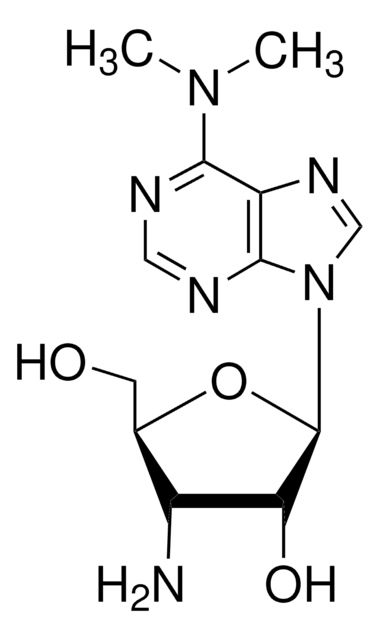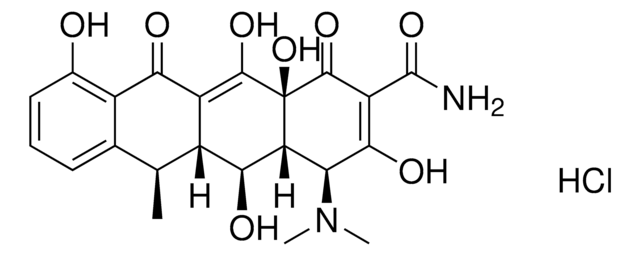おすすめの製品
アッセイ
≥98%
品質水準
フォーム
liquid
濃度
10 mg/mL in water
抗生物質活性スペクトル
Gram-positive bacteria
neoplastics
parasites
作用機序
protein synthesis | interferes
保管温度
2-8°C
SMILES記法
N[C@H]1[C@@H](O)[C@H](N(C=N2)C3=C2C(N(C)C)=NC=N3)O[C@@H]1CO
InChI
1S/C12H18N6O3/c1-17(2)10-8-11(15-4-14-10)18(5-16-8)12-9(20)7(13)6(3-19)21-12/h4-7,9,12,19-20H,3,13H2,1-2H3
InChI Key
RYSMHWILUNYBFW-UHFFFAOYSA-N
生物化学的/生理学的作用
Puromycin aminonucleoside is an aminonucleoside derivative of the known antibiotic puromycin. Puromycin aminonucleoside has been used in nephrology research, studying focal and segmental glomerulosclerosis, and in the induction of nephrosis in rats. Rats with puromycin aminonucleoside-induced nephrotic syndrome were used to study the excretion of sodium and NOx metabolites.
Puromycin aminonucleoside has also been used to probe endothelial glycosaminoglycan synthesis in cultured glomerular endothelial cells and their relation to cell permeability. A puromycin aminonucleoside nephrosis model of rat glomerular disease was also used to study the role of the neuron-specific ubiquitin C-terminal hydrolase protein gene product 9.5 (PGP 9.5).
Puromycin aminonucleoside has also been used to probe endothelial glycosaminoglycan synthesis in cultured glomerular endothelial cells and their relation to cell permeability. A puromycin aminonucleoside nephrosis model of rat glomerular disease was also used to study the role of the neuron-specific ubiquitin C-terminal hydrolase protein gene product 9.5 (PGP 9.5).
調製ノート
Puromycin aminonucleoside solution is provided at 10 mg/mL in water and could be further diluted in aqueous buffers to a working concentration of 10 μg/mL (1:1000).
保管分類コード
10 - Combustible liquids
WGK
WGK 2
引火点(°F)
Not applicable
引火点(℃)
Not applicable
最新バージョンのいずれかを選択してください:
この製品を見ている人はこちらもチェック
Khalil Udwan et al.
The Journal of biological chemistry, 291(21), 11105-11113 (2016-04-02)
Water accumulation in the interstitium (edema) and the peritoneum (ascites) of nephrotic patients is classically thought to stem from the prevailing low plasma albumin concentration and the decreased transcapillary oncotic pressure gradient. However, several clinical and experimental observations suggest that
Agnes B Fogo
Seminars in nephrology, 23(2), 161-171 (2003-04-22)
Glomerulosclerosis in a heterogeneous pattern, ie, focal and segmental glomerulosclerosis (FSGS), is a common endpoint in a variety of settings, including idiopathic FSGS, and scarring secondary to other renal or systemic diseases. These different causes contribute to the diverse clinical
I Shirato et al.
Journal of the American Society of Nephrology : JASN, 11(12), 2381-2386 (2000-11-30)
Parietal epithelial cells (PEC) of Bowman's capsules cover the inner aspect of Bowman's capsules and are believed to contribute to extracapillary lesions of glomerulonephritis such as crescent formation. In glomerular research including cell culture experiments and pathology, differentiation between PEC
Jenny Sörensson et al.
American journal of physiology. Renal physiology, 284(2), F373-F380 (2002-10-22)
It has been suggested that proteinuria is caused by alterations of the charge selectivity of the basement membrane and/or the epithelial cell layer (podocytes). However, recent findings suggest that the endothelial luminal surface coat, consisting of proteoglycans with their connected
Alicia A McDonough et al.
Current opinion in nephrology and hypertension, 12(5), 533-541 (2003-08-16)
The proximal tubule sodium/hydrogen exchanger continuously reabsorbs the bulk of the filtered sodium, controlling salt delivery to the distal nephron which is critical for tubuloglomerular feedback autoregulation and for fine control of salt excretion in the distal nephron. This review
ライフサイエンス、有機合成、材料科学、クロマトグラフィー、分析など、あらゆる分野の研究に経験のあるメンバーがおります。.
製品に関するお問い合わせはこちら(テクニカルサービス)










